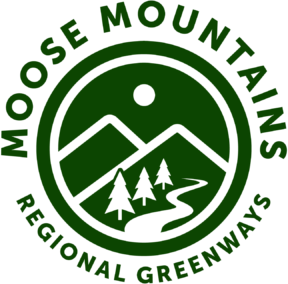Susan Morse Captivates Audience at Slide Show and Tracking Workshops
Thanks to Kate Wilcox for these photos of the Tracking Workshops.
Wildlife biologist and conservationist Susan Morse captivated an audience of two hundred with her photos and tales of cougars and other large North American carnivores on a recent Friday evening at Kingswood Performing Arts Center. She also led two Saturday field tracking workshops at Split Rock Conservation Area in Brookfield, during which participants observed signs of fisher, moose and bear and learned how animals communicate with each other. Both events were hosted by local land trust Moose Mountains Regional Greenways.
Morse is an advocate for wildlife andland conservation, a superb wildlife photographer, an accomplished wildlifetracker and an experienced instructor of those wanting to learn or perfecttheir tracking skills. She founded the award-winning program ‘Keeping Track’,which trains volunteers to observe signs of wildlife in their local communities.
During her Friday slide presentation‘The Cougar Returns to the East,’ Morse discussed the ecological role of apexpredators, such as cougars, badgers and wolves, and how the absence of aspecies at the top of the food chain affects the New England (NE) ecosystem. Althoughcougars have been documented travelers through the East, they are not yetresident or breeding here. Morse pointed out that if cougars were to return tothe East, future populations of deer and beaver would likely stabilize at lowerlevels. She stated that the NE forestedlandscape is excellent habitat for cougars, but westerncougar populations have not grown large enough to trigger their dispersal,likely due to management practices out west that allow cougars to be hunted.
MMRG Board member Jon Nute wasdelighted with the presentation and her focus on land conservation. He remarked,“Great show! We were lucky to have her come. She repeatedly emphasized the valueof protected habitats for all wildlife and praised the work of MMRG and otherconservation organizations to establish islands and greenways corridors ofundeveloped land.”
At Saturday’s tracking workshop,Morse described her method as ‘backtracking.’ Instead of following an animal’stracks, which could stress it, Morse seeks to discover the animal’s history bycareful observation of the forest. Plants can hold a wealth of clues about wildlifehabits and such clues were plentiful on Saturday. Morse found small dot-dashhole patterns in young tree bark, indicating that squirrels had been busytapping the tree for sap in order to consume its sugar and nutrient content. A clump of black bear hair wedged under treebark and a long diagonal cut in the bark where the bear had bitten the tree showedhow it had made its presence known to other bears. Disturbed ground around an odorous tree stump revealedthe stump had been used for scent markings. Morse described the sometimes acrobatic-likemoves employed by fisher and several cat species to deposit their scent.
MMRG Board members Dan Coons andWendy Scriber were both enthusiastic about the tracking workshop they attended.Said Coons, “It was cool to find fresh moose droppings and to identify fisher tracksand see where the fisher had bounced around a streamside.” Scribner added, “It was great how Sue showedus so much more than footprints to look for and explained how and why animalsbehave as they do -- their communication, mating and territorial behaviors.”
MMRG would like to thank Meredith Village Savings Bank and Eastern Propane for sponsoring this weekend of events with Susan Morse. MMRG also thanks New Hampshire Public Radio (NHPR) for its partnership in the post-slide-show discussion, which was moderated by Sam Evans-Brown, host of NHPR’s Outside/In.


